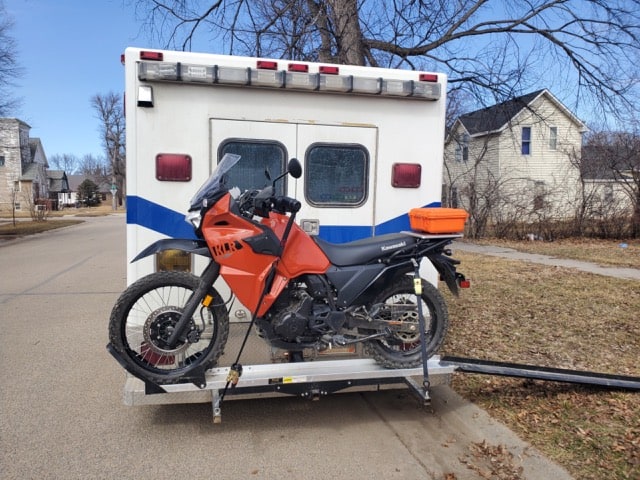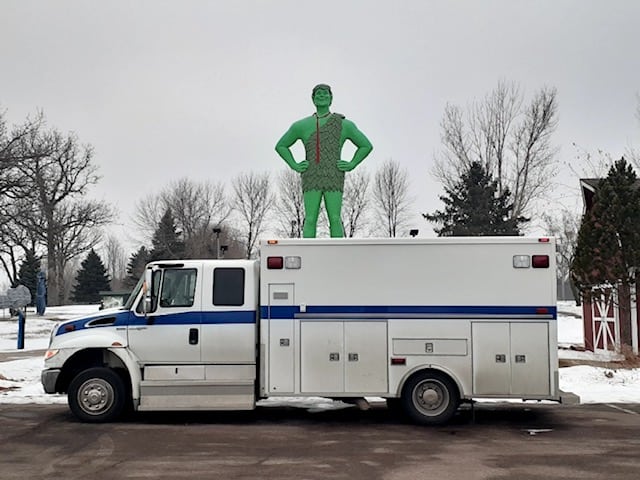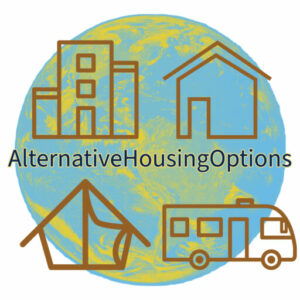Some of you may be scratching your heads wondering what the heck fire to freedom means and how that fits in with an ambulance, much less a converted ambulance house. Take a short walk with me through this interview, and you’ll see how and why you may want to consider an ambulance house or any form of alternative housing for your next home.
It starts with an interview Alternative Housing Options did with a close friend, Phil Gunyon. Phil is an operator at the power plant in South Dakota, about 700 miles from his grown children and grandchildren in Wisconsin and 700 miles from extended family in Indiana. Due to his location, it is a necessity that he travel to visit friends and family when his schedule allows for such trips.
The dream begins
Phil has been an alternative housing enthusiast for all of the 20 years; the writers at AHO have known him. He has explored every kind of off-grid housing imaginable, including cord wood, adobe, strawbale, and tiny homes. None of them hit the mark until he started getting rid of a house full of stuff and had a mindset change that a smaller space with less stuff is better than a large house and a full storage unit.
The goal is solidified

The main challenge Phil saw was that whatever he chose, he wanted to have the freedom to travel and do as he pleased when he retired at 56. With only a couple of years to go, he decided to start searching for his new mobile tiny home. With this newfound realization, he started exploring mobile forms of alternative housing like RVs, van campers, box trucks, and even living out of a small car.
The hunt is on
Phil started surfing websites, looking for just the right truck or van to come up for sale. This process lasted a few months when he was searching and came across a decommissioned 2008 International Fire/EMT ambulance one day. It was owned by the fire station in a small town in Iowa, who had traded it in for a newer vehicle. He took a buddy with him to test drive the rig and found it rode better than he thought. After talking with the dealership, He went home to think about it and see if there were financing options since he would be using it as a home and not just a vehicle. His bank could not give him traditional financing but would do a personal loan with his SUV as collateral. He decided not to mess with that and paid cash for the vehicle.
The ambulance had 120,000 miles. It is an over-the-road style diesel truck that was super clean, with a 1 million mile engine, new tires, and a new starter. The perfect rig to renovate and start his soon to be retired lifestyle at a purchase price of $22,500.
Converting the ambulance

Unlike other vehicle conversion stories, Phil did not gut the whole thing and turn the inside into a more traditional-looking home with wood cabinets and built-in storage. His thinking was that the 2008 international with an all-aluminum frame was built to withstand possible rollover accidents while having a patient inside. It is one tough truck. It also has all kinds of compartments that lock and countertops if you were using it for emergency medical services—the perfect built-ins for an ambulance house.
Instead of gutting it, he worked with what was there and took out one of the rear seats and added a platform for a queen bed. The bed takes up most of the space in the rear, but he had his kitchen, desk, and storage area next to his bed with the countertops in place. With the addition of a few necessities like a cartridge toilet and a single-burner camping stove, he has all he needs to hit the road and stay anywhere he can park.
Future renovations

While Phil is still a short time away from retirement, he has taken his ambulance home named “Big Beautiful” on a couple of multi-state road trips and has decided to make some changes to the home. He will be adding a shower unit to eliminate relying on close contacts when he’s out traveling. State parks, truck stops, and friends and family have shower facilities to use, but a shower unit would remove that worry.
He is also currently exploring solar to provide battery power for the heating and air conditioning system. The current HVAC runs on the truck’s internal system, and the back of the ambulance has a separate system powered by the battery, but you need to keep the truck running to use it. When the fuel prices were $2-3/gallon, that wasn’t an issue but now, at $5/gallon, keeping the truck running when not traveling costs more. He recently filled up his 40-gallon tank, and the cost was $200. Not too bad if you have the current income to cover added costs, but it could become a hindrance if the prices reach $6-7/gallon and you’re living in the ambulance full-time.
So to offset future costs, Phill will need 12–14 solar panels to provide 1200–1400 watts in power to run a mini-fridge, radio, fan, portable a/c, and other devices. Since the pandemic, the cost of the solar panels has doubled, and he is estimating his solar system with panels, batteries, and hook-ups will cost around $5,000, so he has these on a watch list to purchase later.
What full-time ambulance life looks like
We asked Phil what a full-time ambulance life would look like for him, and he said, “I don’t need much. When people see me out and want to look inside the ambulance, they are surprised at what is missing over what I have. They ask about television and how I live in such a small space, without the fancy glide-outs of a $700,000 RV with extra rooms and a full kitchen. I tell them I can do fine with my single burner camp stove and cartridge toilet. I have all the necessities, a place to sleep, storage for food, and the ability to move whenever I want to.”

Pros of an ambulance house
Because Phil already lives on a strict budget (he’s saving for his renovations and future retirement), the cost savings of the ambulance house is not as dramatic for him as they may be for others who deal with high housing costs.
- Cheaper than a hotel or house is a significant advantage of an ambulance house, where even the cheapest hotels are between $80-100 per night and where rent or a mortgage is between $500–$5,000 a month. Phil thinks it will cost him between $400-500 a month for the typical necessities of food, fuel, showering, and parking. Especially if he visits the known boondocking areas or stays in a state park as he travels.
- Food costs will be less. Even staying in a hotel, you’ll need to pay for an average of 2 meals. However, with your house with you, as you travel, coolers and shelf-stable foodstuffs can allow you only to dine out when you want to.
- No snow or house maintenance- while Phil still plans on visiting the midwest, his travels will take him up and down the west coast, where he won’t need to worry about shoveling snow or fixing a broken water heater. Yes, the ambulance may have repairs, and we will talk about those costs in the disadvantages section, but they are less frequent and less costly than maintaining a traditional house.
- Hotshot jobs- in Phil’s line of work in the power plant industry, he can travel and work small, fill in positions to pick up some extra cash if necessary.
- Freedom – this is the most significant factor to Phil and probably many traveling alternative housing owners. He can come in late and not disturb neighbors because he probably doesn’t have any like in an apartment or condo. If he doesn’t like an area, he can drive to a new one and check that out. It is much cheaper than a mortgage or rent.
Cons of an ambulance house
- Maintenance- this particular vehicle has unique components that cost more than a typical car, truck, RV, or motor home. However, they are usually suitable for 7-10 years once fixed. For example, when he purchased the vehicle, it needed a new starter and new tires, the starter was $800, and the tires were $2,400 for this truck.
- Breaking down – traveling with your house can cause a few unique problems you may not have if you were traveling from place to place by car. Phil carries a special RV package from AAA because towing this truck requires a flatbed, not a regular tow truck. He can still stay in it at night wherever it is parked but would need an extra vehicle to get around during the day while the work is being completed.
- Insurance – while you would pay for homeowners insurance when you own a home, around $1,383 per year for $250,000 according to Bankrate.com, and renters insurance when you rent, around $10 a month, an ambulance truck used for a home requires RV insurance which is $1,000 per year according to Phil.
- Storage – Storage, as you can imagine, is an issue. You can’t bring it all with you in a small space like an ambulance. Phil has given away, sold, or thrown out most of his unused or rarely used belongings, but he still has a storage garage that he rents to store his motorcycle, kayak, and shop tools. This runs about $300 per month.
- Disrespect- Phil has noticed that people forced into a traveling lifestyle have taken advantage of parking spots and disrespected the businesses by leaving their garbage behind when they move. This disrespect is the type of behavior that will wreck boondocking for the folks, like him, who don’t leave anything behind.
Costs to live in an ambulance home full-time
Phil discussed his plans of traveling in his ambulance truck and figured that the total cost he is looking at covering monthly is between $400–500. He joked and said it would probably be more because he would be able to finally travel and explore like he’s wanted to for some time. We talked about the difference in costs between renting and traveling/parking fees. He said that once all of the leases are up and he gets his HVAC and shower system paid, his overall costs will be about half of what he currently spends on living and traveling.
Traveling alternative housing can be a hard transition for people, especially if they didn’t choose it, for example, someone who has found themselves homeless and is forced to live in their car. It is a much easier transition for those who choose to live in a small space, with less stuff and the freedom to travel. That is the major pull behind full-time living in an ambulance house for Phil, the freedom to live where he wants, as he wants, and to enjoy life.
To Phil, one thing is for sure: the freedom of having a traveling home and living an alternative housing lifestyle is worth every penny. You can find Phil and his adventures with Big Beautiful on YouTube.
Check out our other alternative housing options for those who like to travel.

